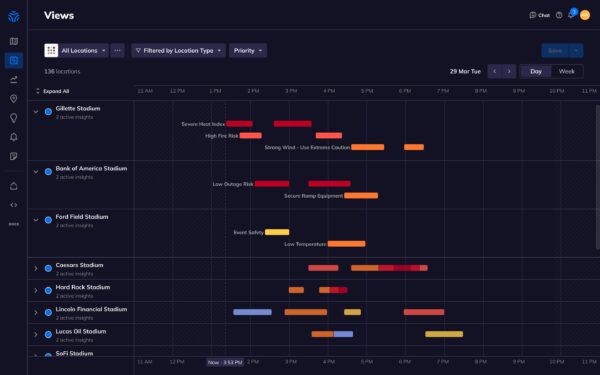TL;DR:
- Airport snow removal is a high-cost and high-stakes operation that requires adherence to guidelines for safety.
- Snow removal costs at major airports can be staggering, with equipment, de-icing, and personnel being major expenses.
- Efficient snow removal operations at airports like MSP involve dedicated teams, advanced technologies, and detailed plans.
- Weather intelligence from Tomorrow.io can provide pinpoint solutions for forecasting snow removal and optimizing crew scheduling and equipment usage.
- By utilizing Tomorrow.io, aviation organizations can reduce flight cancellations and waste from unnecessary snow removal operations.
Airport snow removal is both a high-cost and a high-stakes operation.
To adhere to guidelines, aircraft must be adequately de-iced and snow removal mitigated correctly, or the overall safety of flight and operations is significantly reduced.
The cost of airport snow removal is very high: major international hub airports operate hundreds of pieces of machinery, using thousands of gallons of fuel, and spray several thousands of gallons of anti-ice and de-icing fluids—all the while managing and employing hundreds of seasonal workers.
Expensive snow removal ❄️
📸 airport_ops pic.twitter.com/V6GmTa17Om
— Aviation (@webflite) October 20, 2022
With the right technology, these high costs can be reduced through proactive risk mitigation. Here’s how weather intelligence can reduce your overall snow removal costs by utilizing weather intelligence and automated decision-making.
The Cost of Snow Removal
Snow removal is one of the most costly airport operations. A comprehensive study on the cost of airport snow removal was conducted in 2012, and the numbers are staggering.
At the time, Philadelphia International employed about 180 snow removal employees. During any storm event, snow removal equipment was in continuous operation for eleven to twenty-four hours, with equipment costs ranging from $10,000 to nearly $75,000 in a twenty-four-hour period.
De-icing costs are also a huge economic factor. In the same span of storms sampled, de-icing costs ranged from about $7,000 to $43,500.
The cost is enormous when you spread these figures out across an entire winter season. But beyond the cost of equipment and services, personnel are the highest cost asset in the snow removal process.
Plowing the runways @Dulles_Airport costs $25,000 an hour and takes about 120 people working 2 around the clock shifts. Take a look at how they do it: pic.twitter.com/U4OHi6LgWy
— Sam Sweeney (@SweeneyABC) March 22, 2018
Here’s just one example of snow removal operations at a major airport in the U.S.
Efficient Snow Removal Operations at Minneapolis-St. Paul International Airport
Snow removal at Minneapolis-St. Paul International Airport (MSP) is a significant expense, accounting for 82% of the airport’s airfield maintenance budget. To efficiently handle snow removal operations, MSP has a dedicated team of 110 full-time employees who work alongside temporary workers during the winter season. This collaborative effort ensures that the airport can effectively clear snow and maintain safe operating conditions for aircraft.
The airport’s snow removal operations involve a comprehensive playbook that outlines various strategies and procedures. This playbook includes detailed plans for plowing, deicing, and anti-icing activities, as well as guidelines for equipment usage and prioritization of areas to be cleared. By following these established protocols, MSP can streamline its snow removal operations and minimize disruptions to flight schedules.
To enhance efficiency, MSP also utilizes advanced technologies such as automated snow removal equipment and real-time monitoring systems. These technologies enable the airport to optimize its snow removal efforts and respond promptly to changing weather conditions.
The Snow Removal Process
A snow and ice control plan is mandatory at all air-carrying airports subject to winter weather, which is part of the Part 139 certification process.
The process is well defined and laid out by the FAA. There are specific, measurable time targets that airport operators must meet depending on the annual enplanements. They go as far as defining the required airport snow and ice control equipment and strategies to employ.
However, they do not indicate the best methods for predicting when and how many auxiliary crews should be called up for snow removal. In addition, they don’t indicate when de-icing fluid will need to be pulled from bulk storage, put in trucks, and warmed.
Typically, once a winter storm threat is identified, snow removal equipment is fueled up and prepared. Seasonal staff is brought in on standby. De-icing trucks are filled up and plugged in to keep the solution warm. This usual process is built around decades of experience based on a highly generalized threat assessment. But as we have seen, snowfall and other winter precipitation accumulation can vary widely over the space of just a few miles.
How Tomorrow.io Can Help
The processes used to forecast snow removal have evolved over the years and that’s where weather intelligence comes in.
Instead of the broad, “shotgun blast” approach that airport operators have been working with in the past, Tomorrow.io provides pinpoint solutions with detailed timeframes and intensities.
How much of a game-changer would it be to know that the expected snowfall rate will be between 0.7 inches and 1.5 inches, from 1300 through 1640? And that the snowfall becomes more intense through this timeframe, with some overlap, but then have a two-hour gap between intense snowfall later on?
These types of actionable insights are what a solution like Tomorrow.io can provide. With this pinpoint precision on both time and intensity, aviation professionals can schedule crews accordingly.
How?
With Tomorrow.io’s hour-by-hour monitoring, teams can easily calculate snow accumulation and pair that number with how much a given piece of equipment removes in a given timeframe. The operations department can then schedule crews accordingly and keep auxiliary teams on-call instead of on-site. As a result, only the necessary equipment and crews will be in operation instead of idling the whole fleet.

Tomorrow.io Weather Intelligence Insights Dashboard
For airline operations, a much clearer picture of slot availability is painted. This allows airlines to get ahead of the curve in cancellations and, ultimately, operate proactively instead of reactively.
And we’re already supporting airlines in these endeavors. Companies like JetBlue, Delta, and United, leverage Tomorrow.io to make the right decisions at the right time for their operations.
It is estimated that winter weather results in 60,000 flight cancellations and about $3 billion annually. Some of this is unavoidable, but not all.
We’re already helping JetBlue save on those costs, “In a business where time is money, JetBlue says micro-forecasting is already saving them $300,000 every month, $3.7 million a year,” says Tom Costello on NBC Nightly News.
With Tomorrow.io, your team can mitigate the risk of cancellations and reduce the waste from unnecessary airport snow removal operations like excess staff, and aircraft de-icing.
Learn more about how Tomorrow.io support aviation operations today.

















